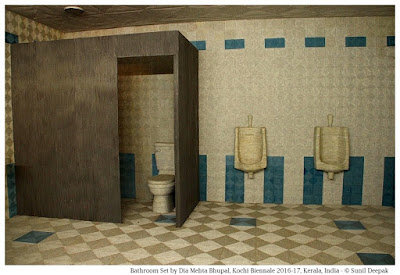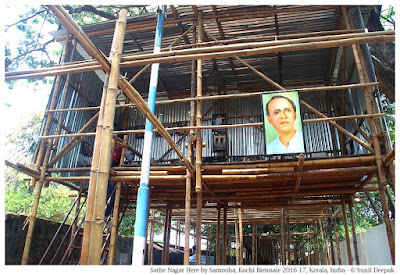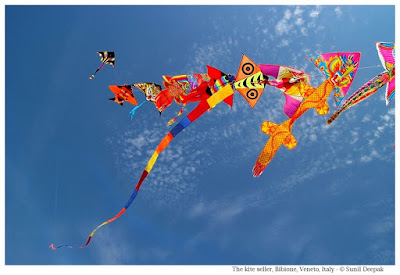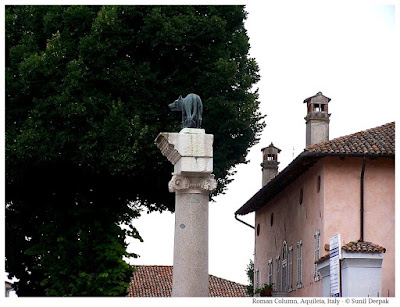The image below shows the famous Chinese fishing nets of Fort Kochi.
Art at the Biennale touched on all the different ways of human expression - paintings, sculptures, architecture, sounds and videos. Appreciating some of them required sitting down, without feeling rushed. However I had little time and I wanted to see a lot of things, so that was not easy.
The location of Fort Kochi, especially the old ruined buildings next to the sea, contributed to the experience of appreciating art. For example, the image below shows the installation, “Shell Mycelium – Degradation movement manifesto” by Asif Rehman Junaid, Giambattista Areddia and Mohamad Yassin, at the Dutch Warehouse (MAP). I felt that the location with the ruins added so much to this installation.
First, I want to tell about three of my favourite art experiences from the Biennale. For me art is all about emotions and feelings. Thus, my favourite art experiences were those that had a strong emotional impact on me.
1. INVERSO MUNDUS BY AES+F
This video installation at Anand Warehouse of Fort Kochi was the best experience I had at the Biennale. The video was projected on a huge screen. It was very powerful and provocative.
First, I want to tell about three of my favourite art experiences from the Biennale. For me art is all about emotions and feelings. Thus, my favourite art experiences were those that had a strong emotional impact on me.
1. INVERSO MUNDUS BY AES+F
This video installation at Anand Warehouse of Fort Kochi was the best experience I had at the Biennale. The video was projected on a huge screen. It was very powerful and provocative.
It was by AES+F. It made me think about things we take for granted in the daily life - it turned them upside down. For example, the way we treat animals, the way we treat women and the new areas of scientific research.
One episode had a butcher guy hanging upside down. Then a pig came and opened the guy’s tummy with a knife, to let the blood drain out, as the butchers do with the pigs.
Ales Steger is from Slovenia. His installation at the compound of Aspinwall House had a pyramid with sound recordings of poets who were exiled from their countries. The poets included Bertolt Brecht, Dante Allighieri, Mahmoud Darwish and Ivan Blatn.
Perhaps it was this state of heightened awareness that contributed to making it a strong emotional experience. The textures of the wall, the smell of mud and wood, the voices of the poets and the suffocating darkness, they were all part of this art experience.
3. TWELVE STORIES OF P. K. SADANANDAN
P. K. Sadanandan is from Thrissur (Kerala, India). His “Twelve stories of the 12 progeny” was a mural painted with natural pigments.
OTHER ART AT BIENNALE WHICH I LIKED
Apart from the above three art installations which had a strong impact on me, I also liked the following works:
Go Playces: Orijit Sen’s installation had city maps composed of persons, families, shops and events of daily life. These events intersected with the stories of his experiences of visiting these cities. Some of those experiences were represented on magnetic jig-saw puzzle pieces. Thus, the interactive installation invited visitors to imagine the location of those jigsaw puzzle pieces on the maps.
Riff Off by Bob Gramsma: A huge concrete wall fallen inside a mud pit may seem to be a very unlikely art installation. Many persons would have difficulty in seeing the “art” in it. Yet, it had a strong emotional impact on me.
I am not so sure why it had that impact on me. Perhaps it was the idea of seeing the space created by excavation, not as an empty void, but as a steel and concrete structure.
Bathroom set: Dia Mehta Bhupal (Mumbai, India) had two installations in Biennale. I liked her “Bathroom Set” (it was more of a male urinal rather than a bathroom) in blue, grey and white. It had a strong impact on me because it made me look differently at a place often associated with strong unpleasant smells.
Big Dog: Liu Wei is from China. Her installation used oxhide, used for making chewing toys for dogs. She had used oxhide to construct Greek temples, amphitheatres and Roman arches - models of classical Roman/Greek architecture, made from animal skin.
Room for lies: Sunil Padwal (Mumbai, India) brought together daily-life objects of the past, filling the walls with murals of nostalgia.
Secret Dialogues: During my visit, the artist C. Bhagyanath (Thalassery, India) was in the room where his works were displayed.
Where the flowers still grow: Bharat Sikka (New Delhi, India) presented a series of photographs and some daily life objects from Kashmir to express his feelings of living in a war zone and how people try to continue to live in spite of everything.
I thought that the photographs and objects he had selected were interesting. For example, among the objects was a box of ammunition that could have belonged to militants or to the Indian army. It also made me think of army persons who live far away from their homes and families and how the violence and war experiences change them.
Tears of Taj Mahal: Ouyang Jianghe uses calligraphy to create textual sculptures. I love the idea of sculptures of words. It reminds me somehow of the white-books sculptures of the Italian artist Lorenzo Perrone, though the two have completely different concepts.
The Pavillion: The Pavillion was a hall at the Cabral Yard where they held meetings, interviews and events of the Biennale. Tony Joseph (Calicut, India) was the architect of this pavillion. I loved the ceiling of the hall covered with saris and lit by lights in changing colours.
Kissa Kursi Ka: A series of installations on the theme of chairs was organised at Heritage Art gallery near the Jewish Synagogue in Mattancherry. The installation by Gunajan Gupta had the background of traditional arts from Kerala and other parts of India. It explored the links between art and design.
Kochi Biennale 2016-17 with more than 90 artists from a large number of countries, was a wonderful opportunity to see how the ideas and concepts of art are evolving. My conclusion was that art has blurred boundaries.
I felt that short abstract videos, like an installation that explored the rain drops falling on a window pane, was easy to consider as art – because it was about sensations and emotions and not about a story. But “Inversus Mundus” was very clearly a film with episodes and short stories or ideas. I could have seen it as a part of a film festival. So there was this blurring of boundaries between the art-forms that seems to be part of the contemporary understandings about art.
I was also not sure about computer generated art, such as the three-D printed sculptures. I felt as if the artist had cheated by using the three-D printing instead of actually sculpting. Probably, this only means that I belong to an older generation!
I want to conclude this post with another image of an art installation that I liked. It was called Fish Cemetery. It was located on the Fort Kochi beach and was not part of the Art Biennale. Its objective was to creare awareness about environment. It was by Manoj Brahmamangalam and Pramod Gopalakrishnan.
***







































































